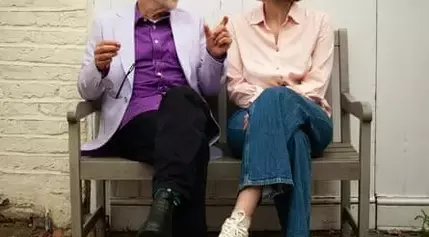In a cozy, light-filled studio tucked away in Notting Hill, renowned musician Brian Eno and Dutch artist Bette Adriaanse collaborated on a unique project. Their new book, What Art Does, explores the essence of art and its role in society. Through this collaboration, they delve into the importance of creativity in education and daily life, challenging traditional views on what constitutes art. The conversation reveals their shared vision of art as a universal language that transcends boundaries and invites everyone to participate.
A Meeting of Minds in a Golden Autumn Afternoon
On a crisp autumn afternoon, I found myself standing before a charmingly diminutive entrance leading to an expansive, sunlit studio in Notting Hill. Inside, the air was filled with the soft melody of an ethereal piano tune. Brian Eno, dressed in a vibrant purple shirt, was quietly engrossed in signing copies of his latest collaborative work, while Bette Adriaanse worked alongside him. The atmosphere was warm and inviting, much like the Moroccan tea Eno offered me, its aroma rich with hints of dates and roses.
Their collaboration began at a dinner hosted by literary agent John Brockman, where they discovered a mutual interest in answering the same fundamental question: What is the purpose of art? Both Eno and Adriaanse had long been pondering this mystery from different perspectives. Eno, who started his career as an art student in the 1960s, has always been fascinated by the intersection of music and visual arts. Adriaanse, a polymath with experience as a writer, artist, and teacher, brought her practical insights into the classroom, where she struggled to define the essence of art for her students.
Their book, What Art Does, is both a simple yet profound exploration of how art permeates every aspect of human life. It challenges the notion that art is reserved for galleries or museums, arguing instead that it is an intrinsic part of everyday activities—from choosing clothes to attending social events. The book also emphasizes the importance of play in fostering creativity, suggesting that art allows us to safely explore emotions and imagine new possibilities.
Eno's reluctance to discuss his past musical achievements became evident during our conversation. He expressed discomfort with being placed on a pedestal, preferring to focus on the present and future. For him, art is not about individual genius but about collective creativity—a concept he calls "scenius." This idea celebrates the collaborative nature of artistic movements, recognizing the contributions of curators, critics, and even casual observers.
When asked about the impact of artificial intelligence on art, Eno remained skeptical. While acknowledging the potential of AI to create compelling works, he emphasized the importance of human intentionality and curation. He believes that true art requires a human touch, someone to guide and refine the creative process.
An Invitation to Embrace Creativity
What struck me most about this encounter was the genuine enthusiasm both Eno and Adriaanse have for sparking creativity in others. They remind us that art is not something distant or unattainable; it is within each of us, waiting to be discovered. Their book serves as a joyful manifesto, encouraging readers to embrace their "deep likes" and find joy in the act of creation. Whether through music, writing, or simply appreciating the beauty around us, we all have the capacity to contribute to the world of art.
In a world often dominated by technology and data, Eno and Adriaanse’s message is a refreshing reminder of the power of human imagination. By focusing on the present and fostering a spirit of play, they invite us to rediscover the artistry in our daily lives and to recognize that we are all capable of creating something meaningful.

